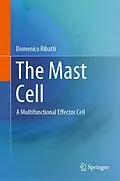This book covers the most important aspects of Mast Cell Biology. It enables the reader to immerse in the new aspects of Mast Cells biology, which are no longer seen as an immunological effector cell, but a multi-functional efector cell. One which have roles that expands beyond the immunological realm and shows deep implications in the pathophysiology of several human disorders as well as transforming into a very important and promising target for therapy development in cancer, neurodegerative disorders, angiogenesis, inflammation and allergy.
Autorentext
Klappentext
Mast cells (MC) are phylogenetically old cells which are distributed throughout the human organism. MC are found in almost all of the major organs and tissues of the body, particularly in association with connective tissue structures such as blood vessels, lymphatic vessels and nerves, and in proximity to surfaces that interface the external environment, such as those of the respiratory and gastrointestinal system and the skin. This selective accumulation at tissue sites where foreign material attempts to invade the host suggests that MC are among the first cells to initiate defensive mechanisms. MC have long been recognized as key cells of type I hypersensitivity reactions. Several lines of evidence, however, indicate that they not only express critical effector functions in classic IgE-associated allergic disorders, but also play important roles in host defense against parasites, bacteria and perhaps even viruses. Indeed, it is now clear that MC can contribute to host defense in the context of either acquired or innate immune responses through the release of a myriad of pro-inflammatory and immunoregulatory molecules and the expression of a wide spectrum of surface receptors for cytokines and chemokines. Moreover, there is growing evidence that MC exert distinct non-immunological functions, playing a relevant role in tissue homeostasis, remodeling and fibrosis as well as in the processes of tissue angiogenesis.
Inhalt
1. Foreword
2. Mast cell ontogeny
2.1. Background
2.2. First evidence of bone marrow origin
2.3. Development of mast cells along the myeloid pathway2.4. Stem cell factor
2.5. Integrins and cell adhesion molecules
2.6. Chemokine receptors and interleukins
3. Staining of mast cells
3.1.Background
3.2. Metachromasia3.3. Alcian blue-safranin
3.4. The tyrosine kinase kit receptor
3.5. Tryptase and chymase3.6. Other stainings
4. Mast cells heterogeneity
4.1. Background
4.2. Mast cells in thymus4.3. Mast cells in duodenum
4.4. Mast cells in mammary gland
4.5. Other localizations4.6. Mechanistic insights
5. Mast cell biology and functions
5.1.Background
5.2.Mast cell derived secretory products5.3.Mast cell immunological functions
5.4.Mast cell non-immunological functions
6. Mast cells in arteriogenesis
6.1.Background
6.2.Factors involved in angiogenesis and arteriogenesis6.3.Inflammatory cells in arteriogenesis
6.4.Mast cells in arteriogenesis
6.5.Perspectives
7. Mast cells in primary systemic vasculitides
7.1.Background
7.2.Experimental evidence of the involvement of mast cells in vasculitides
7.3.Clinical evidence of the involvement of mast cells in vasculitides
7.4.Therapeutic perespectives
8. Mast cells in blood-brain barrier alterations and neurodegenerative diseases
8.1.The blood-brain barrier
8.2.Mast cells in the brain
8.3.Mast cells in cerebral ischemia
8.4.Mast cells in multiple sclerosis8.5.Mast cells in angiogenesis in diseases associated with blood brain barrier alterations
8.6.Perspectives
9. Mast cells and basophils: a link between angiogenesis and inflammation in allergic diseases
9.1.General biology and mediators of mast cells and basophils
9.2.Mast cells and basophils in allergy9.3.Mast cells and basophils in inflammation, angiogenesis and tissue remodeling
10. Mast cells in tumor fate
10.1. Tumor microenvironment
10.2. Mast cells and tumor growth: pros and cons
11. Mast cells in tumor angiogenesis and lymphoangiogenesis
11.1. Mediators released by human mast cells involved in the angiogenic response
11.2. The CAM assay in the study of mast cell-induced angiogenesis
11.3. Mast cells in experimental tumor angi...
